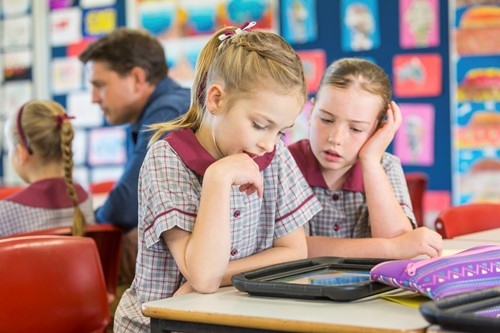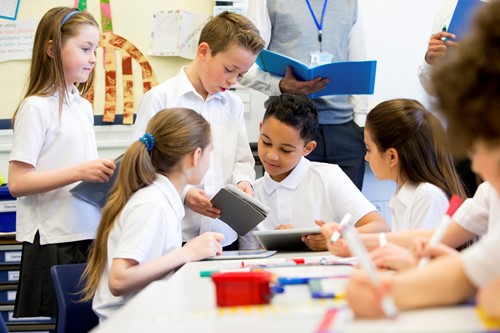As primary schools continue to advance into the digital era, into a time of knowledge wealth, governments such as that in Australia are strongly encouraging the use of technology in primary education. In the past decade, its primary curriculum has reflected this by including ample opportunities for teachers to integrate ICT in primary education.
However, the effective use of ICT in primary schools in my view is not so much about the development of ICT skills for primary students, but to develop their ICT capability. There is a growing consensus that it is the development of ICT capability rather than ICT skills for students that should be the focus of ICT in education. This is because anyone can know an ICT skill or a number of ICT techniques. Yet, to be ICT capable is to ‘know that you know’ such ICT techniques and be able to decide whether these ICT techniques are appropriate to the context and will develop the right ICT solution.
There are so many benefits of ICT in primary schools and developing student ICT capability should be a priority for teachers. You may have already noticed that other benefits include motivation and engagement just to name a few.
What will make this article different from the rest is that it will answer your questions about not only technology in primary schools, but I will share with you my top ICT teaching and learning strategies to help you successfully integrate ICT in the primary classroom today.
Let us first examine what is ICT in primary school?
ICT in the classroom
There are different types of ICT for primary school education, however, the ones which you will learn about here will enable you to develop ICT skills for primary students through the process of learning how to develop ICT capability.
ICT skills and techniques is just one component of ICT capability and it is essential that you go beyond this and plan and seek to develop all components of ICT capability. These include routines, processes, concepts and higher order thinking skills.
Information and Communication Technology in primary schools include:
Word Processing
ICT skills for students here include saving documents, typing skills and particularly sending documents to a printer. Children are expected to exit primary school with the following capabilities:
- Changing font, font size, bold, italics, highlight and font colour;
- Justifying, changing spacing, indenting;
- Setting up bullets and numbers, re-starting numbered lists;
- Inserting and modifying a table;
- Inserting a blank page and understanding why this is used;
- Inserting a picture – embedding it tightly with text, understanding how to resize and re-position it;
- Inserting graphics, tables, smart art and symbols;
- Understanding how to set up a header, footer, page numbers;
- Inserting hyperlink, setting how the linked pages opens;
- Using templates.
As a teacher, what then do you need to know for when teaching ICT in primary school?
You will need to apply your knowledge, skills and understanding of word processing in two distinct ways. The first way is when you teach with ICT such as word processors and the other relates to your professional practice. For the purpose of this article, however, we are focused on the latter.
What ICT skills do teachers need for when teaching ICT in primary schools such as word processors? For you to be able to teach with ICT effectively in this instance will require you to have knowledge, skills and understanding of the following ICT skills for teachers:
- Creating, opening, saving, closing, deleting and printing documents;
- Selecting font, font size, colour, style (italic, bold), line spacing and justification;
- Inserting, deleting, selecting, cutting, copying, pasting and undoing;
- Utilising help;
- Inserting bullet points, tables, clip art, borders, shading and columns;
- Altering page orientation (landscape, portrait), background colour, page size and margins;
- Altering defaults;
- Forcing page breaks;
- Utilising tabs and indents;
- Utilising spelling- and grammar-checkers (including how to switch on and off), thesaurus, print preview, highlighter and talking facilities (including how to switch on and off) and find and replace;
- Connecting alternative input devices (overlay keyboards, touch screens);
- Constructing and utilising on-screen word banks;
- Inserting page numbers;
- Inserting text, graphics, tables and documents from other applications.
Additional teacher ICT skills may also include:
- Inserting symbols, headers and footers;
- Creating macros and templates;
- Utilising dynamic links between documents;
- Customising the word processor;
- Merging documents;
- Formatting graphics;
- Protecting documents.
Graphics programs
Classic examples of this type of ICT in primary education include drawing and painting programs which are very useful for creating images for literacy learning. Teacher ICT skills include:
Painting programs –
- creating, opening, closing, deleting and printing documents;
- selecting file type and saving documents;
- selecting page size, margins and page orientation;
- inserting, modifying and deleting background colours and textures;
- selecting, modifying and utilising tools from the tool bar (spray, round brush, draw a circle);
- utilising fill;
- utilising the pipette/choose a colour tool;
- utilising undo/redo;
- selecting, modifying and utilising the text tool (font, font size, colour);
- selecting areas (for cropping, scaling, reshaping, deletion);
- selecting, modifying, utilising and saving repeated images (stamps);
- selecting and utilising more advanced features such as tiling, flipping and rotation;
- switching grid on and off;
- utilising zoom/magnifier and understanding how it differs from image resizing;
- inserting, deleting, manipulating and saving imported images;
- exporting images to other applications;
- clearing the screen;
- utilising help;
- altering defaults;
- customising set up;
- connecting alternative input devices (overlay keyboards, touch screens, graphics tablets);
- protecting documents.
Drawing Programs –
- creating, opening, saving, closing, deleting and printing documents;
- selecting page size, margins and page orientation;
- inserting, modifying and deleting background colours;
- selecting, modifying and utilising tools from the tool bar (line, arrows, shapes);
- utilising fill;
- utilising undo/redo;
- grouping and ungrouping elements;
- selecting, cutting, copying, pasting, cropping, resizing, reshaping, reordering and rotating elements and drawings;
- switching grid on and off;
- utilising zoom/magnifier;
- exporting drawings to other applications;
- utilising help;
- altering defaults;
- customising set up;
- connecting alternative input devices (overlay keyboards, touch screens, graphics tablets);
- protecting documents.
It is important to note that teacher ICT skills should reflect what students need to know. So ICT skills for primary students will also include many of the above.
Spreadsheet
Teaching with and about spreadsheets should involve teacher capabilities such as:
Selecting appropriate opportunities to enhance or extend children’s ICT learning;
Exploring the full range of data-handling activities such as facilitating hypothesis, decision making, organising and analysing;
Making explicit links between related knowledge, skills and understanding across the primary curriculum.
Teacher ICT skills and that of students should include:
- creating, opening, saving, closing, deleting and printing documents;
- selecting worksheet and cell size;
- selecting font and font size;
- inserting, modifying and deleting row and column labels;
- inserting, modifying, moving and deleting textual and numerical data;
- inserting, modifying and deleting formulae and functions;
- using fill down and fill right functions to replicate formulae;
- inserting and deleting cells, rows and columns;
- formatting data, e.g. left alignment, centring around decimal point;
- searching and sorting data;
- adding, modifying and deleting borders and shading;
- selecting, modifying and displaying graph types;
- formatting graphs to include axes labels, key and text;
- exporting graphs and spreadsheets to other applications;
- importing information from other applications, e.g. clip art, data;
- utilising help;
- altering defaults;
- customising the spreadsheet program, e.g. switching off functions not needed;
- utilising alternative input devices, e.g. data-loggers;
- protecting cells and documents.

Teacher Knowledge of ICT Resources and ICT tools
When there is so much ICT for primary school that is out there, I know that as a teacher myself that you can become overwhelmed. The information presented so far hasn’t even covered the true extent of what is ICT in primary education.
Don’t worry…there is more.
Don’t panic either…here’s why.
First of all remember that it is impossible to know all there is to know about ICT in primary school. Later, I will go into more detail about what you can do when teaching ICT in primary schools.
My best advice to give you is to choose just one or two ICT tools and resources that both you and the students are familiar with. Familiarity, however, involves more than just knowing how to use program for a variety of tasks. It means reflecting on the processes it helps the student to carry out and the ICT techniques with which particular effects can be achieved. It also has to do with considering how you would introduce the program to the students. Have you been clear about the ideas before they start? Where might they experience difficulties?
It is more important for you to be knowledgeable about one program that your students will use than to have an acquaintance with a large number. This is also better for the students as they will be able to work with a small number of versatile programs and progressively develop their ICT skills. ICT skills for primary students are, therefore, best developed in carefully structured activities in this process. If you continue to try to develop ICT skills for students in a large number of programs then these skills will be superficial at best.
Searching the Web
Information literacy skills is critical for students living in a knowledge society. Advanced web-searching skills are significant and includes two aspects that need to be covered.
Practical ICT skills for students:
Skills that make web searching more efficient are – Boolean operators and truncation, knowledge how to read URLs (what the difference is between ‘http’ and ‘https’; what does www mean?), and search techniques (how to limit the results).
Boolean searching involves the use of operators such as AND, OR and NOT. These can be used to redefine searches by combining or excluding words or phrases.
Critical ICT skills for students
Understanding domain names and what they mean; knowing which are more trustworthy; knowing which are more useful for information and research.
Animation ICT skills for students
This is one of my favourite ways to develop ICT capability in subjects as it involves:
- Crafting a story;
- Planning the story on a storyboard;
- Planning materials;
- Planning the filming;
- Collecting the digital images;
- Finishing off the visual footage and then recording a narration or soundtrack;
- Writing a script for the narration or soundtrack;
- Merging the visual footage with the sound files;
- Finishing the final product and exporting it into a format that is easily used.
Graphing Programs
Many of the programs already discussed have one core aspect in common and that is the fact the ICT skills for primary students learned are all transferrable. This means that they can be applied to any context and graphing programs are the same.
Teacher ICT skills include select the appropriate opportunities to enhance and extend children’s learning with it, modelling appropriate use of ICT, demonstrating and intervening and making explicit links between knowledge, skills and understanding in key learning areas. This is thus the beginning of how to teach ICT in primary schools.
The modelling of ICT skills for primary students need involve knowing, understanding and demonstrating appropriately the following:
- creating, opening, saving, closing, deleting and printing documents;
- adding, modifying and deleting data;
- plotting and replotting graphs;
- selecting and displaying graph types, including more than one graphical representation of the same data;
- selecting and modifying constituent elements of graphs, such as changing the colours of bars in a bar chart to correspond with the data represented;
- selecting, resizing, cutting, copying and pasting graphs;
- selecting and modifying graph scales and autoscaling;
- selecting two-dimensional or three-dimensional representations;
- inserting graph titles, axes labels, key and text;
- selecting font and font size for graph and axes headings;
- exporting graphs into other applications;
- importing information from other applications, such as clip art;
- utilising help;
- altering defaults;
- customising the graphing program, switching off functions not needed;
- utilising alternative input devices (particularly data-loggers);
- selecting appropriate colours or patterns depending on printer availability (black and white or colour);
- protecting documents.
Presentation Software
Classic examples of this program are PowerPoint, Keynote or Prezi and include similar ICT skills for primary students such as saving documents but may also involve:
- How to select a layout, insert new slides, slide formats;
- How to change font, font size, colour, bold, italics, justify, insert bullets, number lists, indenting, slide orientation;
- How to insert a table, image, clip art, smart art, graphic, movie, sound file, hyperlink;
- How to design your own slide design;
- How to use animations;
- How to create handouts and notes pages.
Blogging
The ICT skills for students here are similar to that of word processing and publishing as blogging is in fact a form of online word processor.

Developing more than just ICT Skills – Teaching ICT in primary schools
The use of primary school technology can make a big difference in teaching ICT techniques when your goal is to develop all the components of ICT capability. The following will show you how to teach ICT in primary schools. These ICT teaching strategies are evidence based and proven to have been successful in what I consider to be the development of ICT skills for primary students in ICT capability facilitation.
First of all, routines that are ICT techniques or skills that don’t require conscious thought, is what you need to establish when using ICT in the primary classroom. On the other hand, ICT techniques or a single ICT skill do require a conscious thought. It is when ICT techniques become automatized that they then become routine.
An example of an ICT technique in early childhood education, for example, would include inserting an image into a document.
It is important that you don’t misconceive the teaching of ICT in primary schools with just teaching and demonstrating ICT skills for primary students. ICT capability involves also processes, concepts and higher order thinking skills. ICT techniques are the explicit, deliberate manifestations of ICT capability.
To teach ICT skills when developing ICT capability you need to do the following:
- When introducing new software tools to children, start by discussing what it can do and how it can be achieved, rather than merely demonstrating a fixed sequence of techniques to achieve a single outcome.
- Students need to associate the actions involved in a technique with the effect it achieves.
- Having a name for the technique and/or effect is helpful.
- The name should be seen not as something extra to learn but as a means of communicating and thinking about the action and its effect.
- This is especially so if the name is used in menu options, but is also helpful where the movements, buttons or shortcuts are used.
- Techniques which has not become routines may be carried out in different contexts using the affordances on the screen (icons, menus) or with help from adults or peers.
- Monitoring and intervening - Useful to have a checklist for each class to enable you to keep track of which student are confident in using the ICT skills and techniques.
- Give students needing help only the minimum of support. This should be withdrawn as soon as possible.
- Processes – more general and are made up of several techniques.
- An understanding of relevant concepts is needed in order to analyse a situation and identify the particular techniques required to reach the desired goal.
- Students need to work on a task which is NOT set out step-by-step. This allows them to try out new ideas and you can observe their approach and intervene when they fail to make the expected progress.
- The minimum level of support should be given. Structure the activity by questioning, prompting and showing if necessary.
- Withdraw as much support as possible to see what the learners can achieve unaided. à a student’s understanding of a process such as developing a poster using a desktop publishing program, or modelling with a spreadsheet, cannot be represented by a checklist. It requires a description of the way in which they approach a task and the support that they need.
- Conceptual understanding – focus on the concepts behind the ICT skills for students. Whole class teaching can be used to discuss examples and non-examples, both with and without ICT, in order to highlight the important features of the concept. Challenge naïve ideas about handling ICT tools and techniques, both in whole class teaching where appropriate, and when monitoring the individual.
ICT skills in education are best taught when developing ICT capability in meaningful subject-related learning activities as young children begin to learn metacognitively – they know that they know - how to use ICT techniques and skills that are appropriate to the context.
To learn more about how you can develop ICT skills for primary students visit our range of online PD workshops for primary school teachers today.

The Best Strategies for Integrating ICT in Primary Schools
As a primary teacher, the ICT teaching and learning strategies that you employ in your lessons should help you to develop ICT capability. This should be your ultimate aim and it is when the use of ICT in the learning activities becomes ‘transparent’ to the students when they are achieving the learning outcomes which you have set for them.
The Issue at Hand
One of the most important ICT teaching strategies that I bestow on my online students, is the fact that this does not necessarily just mean the teaching of ICT techniques/skills. ICT capability is so much more than this and is what makes this capacity building workshop for teachers so important today. It is gaining the understanding, knowledge and expertise that teaching strategies using ICT is NOT about ICT skills teaching and also NOT about simply exposing students to ICT in the classroom. Neither will it develop ICT capability.
The use of ICT in primary education, particularly in Australia, is very important as the ICT Capability Learning Continuum sets the path for teachers to ensure that learning progression. Yet there is a demand for knowledge on evidence based teaching strategies when integrating ICT in the classroom.
The development of ICT capability in learning activities still remains a key issue for many teachers.
Another issue emerging as a result of the ever-increasing pressure on teachers who plan on integrating ICT in the classroom is the rapid rate of technological development. It is a common misconception that the use of any kind of technology in the classroom will add to the development of ICT capability.
This is incorrect.
The application of ICT capability is achieved when teaching and learning with ICT throughout the key learning areas to enhance student learning. However, technology such literacy and numeracy software requires minimal capability on behalf the students and the computer stays in control. The ICT tools used in classroom teaching that we encourage further use of in this workshop allows the students full control and contains the following attributes:
- Recognised as a tool software;
- Can be used in many different applications;
- Intellectually challenges students;
- Content-free or generic;
- The demands and possibilities will depend on whether the main objectives are to learn ICT techniques;
- The level of control and decision-making by students is high.
Gaining further expertise in ICT teaching and learning strategies will boost your own capabilities and you will be able to foster the following ICT teaching strategies that emphasise higher order thinking skills and provide an effective foundation for the challenges of a disjointed secondary curriculum.
Applying Teaching Strategies in Primary School
There are many uses of ICT in primary education and as mentioned earlier, this is mainly due to the pressure that you have as a teacher to incorporate the use of ICT in the classroom. ICT is a complex and powerful tool for learning, but exposure to it will not benefit the students unless supported with teaching strategies for ICT capability development.
Video in Advanced Workshop (Short Preview) - Applying ICT teaching strategies in Primary Science
When it comes to teaching strategies using ICT, the teaching strategies that you need to employ become more complex. Here is why?
- There may be confusion between ICT as a subject, a key skill and as a learning tool – this can lead to a variation in approaches when teaching and learning with ICT.
- Successful for ICT capability comprises of a variety of ICT teaching strategies.
- The components require a variety of conditions for their development, therefore, it is also helpful to identify these components.
- ICT capability is not a once-and-for-all initiative. Progress should be monitored and goals reviewed regularly.
- ICT activities are not isolated from the rest of the curriculum.
The most effective teaching methods for primary teachers are the ones that you will use to support your students in their learning process.
I will give you the expertise you need in order to exploit ICT tools used in classroom teaching such as word processors, paint and drawing programs, coding programs.
You will learn how to apply ICT teaching strategies in the classroom such as the following through real-life, authentic learning experiences:
- Learning how students learn with ICT – provides the groundwork for your understanding and effective employment of ICT teaching strategies when integrating ICT in the classroom.
- Analysing your situation – this involves a level of complexity as the level of ICT capability that you have as a teacher directly impacts your student’s ICT capability development. It also means taking a look at your school’s ICT resource level.
- Make instructional decisions when integrating ICT in the classroom such planning and seeking to develop all components of ICT capability.
- Selecting the appropriate ICT tools used in classroom teaching – significant use of ICT teaching and learning strategies depends on the selection of ICT as tools for learning and ICT capability.
- Supporting and scaffolding ICT capability when integrating ICT in the classroom.
Our capacity building workshop for teachers also supports other ICT teaching and learning strategies such as:
- Putting clarity first to allow for the autonomous selection and use of ICT.
- Personalising instruction through the use of the ICT capability Learning Continuum.
- Incorporating interactive learning.
- Promoting student reflection.
- Cooperation and collaboration in the use of ICT.
Making Instructional Decisions
Learning how children learn with ICT will play a big role in the type of ICT teaching and learning strategies that you employ. While ICT in classrooms might be becoming more popular it is clear through research that simple exposure to ICT is not sufficient in itself to develop student ICT capability and technological literacy.
Ultimately, these ICT teaching strategies should enable you to be able to plan and seek opportunities to develop each component of ICT capability.
I encourage you to join your colleagues in this workshop for teachers when using ICT in primary education. It is essential that in the 21st century classroom that is predominantly digital or ICT-orientated, that you not only choose the right ICT tools for classroom teaching, but support your choices with ICT strategies in the classroom such as the ones that you will learn to employ in meaningful and purposeful learning activities as this develops ICT capability.

Top 5 Reasons why these are the best ICT tools in the classroom today?
These ICT tools for teaching and learning are the best in the primary classroom for the following reasons:
- These ICT tools for learning are affordable - you probably have them in your classroom or school already.
- They are generic - this means that they are widely available and commonly used by both students and teachers.
- Content-free - this type of software challenges children intellectually.
- Children in control of technology - the ICT becomes a tool for learning in a variety of different ways and the demands
- Develop student ICT capability and ICT literacy - this is amplified when you support and scaffold ICT learning in key learning areas.
How to use ICT tools in the Classroom
To unlock the potential of technologies to use in the classroom, you need to:
- Establish a starting point each students' ICT learning and embed formative assessment in a primary school in key learning areas such as literacy and numeracy.
- Plan for progression in ICT learning progression in the Learning Continuum of the Australian Curriculum.
- Employ evidence based ICT teaching strategies that support ICT learning alongside subject learning.
LEARN ALSO ABOUT other ICT tools used in Classroom teaching:
ICT TOOLS AND PEDAGOGY - HOW TO USE ICT TOOLS FOR CLASSROOM LEARNING (Online Workshop)
The Best and Most Appropriate Empowering ICT tools.
Evaluating technology integration in the classroom
Great ICT Learning tools for Language, literacy, and Early Childhood Education.
How does ICT enhance Teaching and Learning?
There is a list of reasons which demonstrate how ICT can enhance teaching and learning in the 21st century. However, some of the main ones include:
- Student motivation.
- Student attainment levels.
- Student engagement in subject learning.
The following list of ICT tools used in classroom teaching is categorised into various areas of learning.
This will then go to illustrate the benefits of each for teachers and students.
INTELLECTUALLY CHALLENGING TECHNOLOGIES TO USE IN THE CLASSROOM
ICT Tools for Developing Literacy
With the 'new literacies' comes new ICT skills as literacy is no longer limited to reading paper books and texts. Today, new literacies brings the learning of new technologies which are essential for students to master if they are to be literate for the 21st century. New technologies can be used to do traditional things in a different, more motivating way. As a consequence, teachers are challenged not only to integrate technology into traditional aspects of literacy instruction but also to engage students in emerging technological literacies.
- Word processing has close links to literacy and language development. Being proficient in word processing skills is something which students will continually use and build on throughout their school career.
- Blogs are an excellent way for students to collaborate and communicate using an online word processor.
- Wikis ('What I Know Is'): These can be a repository of knowledge for students and like blogs, the possibilities for wikis are wide open. There can be research projects, writing projects, and library projects just to name a few.
- Emails - great for developing online literacy skills. We all write differently online and for different audiences too.
- Web creation and design: These are really online word processors and so the possibilities in literacy lessons are endless but can be limited to the teacher's own capabilities in ICT.
- Web searching (Information literacy skills): The ability to find information is a vital skill to have in the 21st century. What strategies are available to navigate electronic texts and the internet? Where are the signposts and clues?
- Drawing and graphics programs: Visual literacy is equally important today than ever before. Imagine demonstrating to your students how to use one of these drawing or graphics programs so that they can use it creatively in order to add an image to a newspaper article, to understand how pictures can sometimes tell a thousand words just by the colour, expressions or medium used
- Digital video: Harness the power of video to help students develop their language skills.
- Spreadsheets and Databases: Who said that these can't be used in English lessons? What about opportunities for the teaching and reinforcement of a range of higher-order language skills, such as keyword selection and the skimming and scanning of text?




ICT Tools to Promote Literacy and Language Development in Early childhood Education
Child development is the most general educational goal for early childhood teachers.
ICT can be used to support the learning and development of both literacy and language in early years education.
This is mostly conducted through collaboration with other children around computers where the quality of discussions can be quite interesting.
- Computers offer a ‘print-rich’ learning environment for young children. You will most likely find that there is a lot more attention to detail in their conversations than in other situations. Some believe that this may to do with the abstraction the computer provides as it allegedly forces children to talk more and physically do less.
- Developmentally appropriate programs - There are a few things that you need to remember in terms of choosing the most developmentally appropriate programs. It is important that you look for programs that promote speaking, listening, reading, and writing. There are programs that can record children’s voices. The Gruffalo App is one such example that allows children to record their voices in time with the story being told. They can then listen to their own voice throughout the story as it is being told.
- Internet - The Internet can also help children learn literacy skills in their home language and in the language of their friends.
- Word processors - these offer possibilities for children to compose and write without needing to have mastered the production of letters by hand. ICT learning tools for early childhood education offers such a variety of ways for children and photos and videos is another method to develop literacy and language skills. The reason why this is the number one activity for this is that it allows children to weave together words and pictures.
So these are the main ICT learning tools that I suggest to use to aide in the development of literacy and language.
There are other tools such as multi-link headphones, digital cameras, webcams, audio recording software, walkie-talkies, telephones that also encourage the development of speaking and listening skills.
Interactive whiteboards and smartboards promote writing skills on a large scale. However, these are mostly used in collaboration with the ones I discussed earlier.
There are many ICT tools that can be implemented successfully in a learning environment. Learning environments in early childhood can now be indoor and outdoor, so these tools can have quite an extensive range.
LEARN ALSO ABOUT:
How to choose meaningful ICT tools and resources.
How do students learn with ICT tools?
12 Awesome ICT tools that will empower children today.
10 Great ICT tools for Science Lessons
5 ICT tools to teach Mathematics

ICT Tools for Primary Schools
READ ABOUT:
9 of the best ICT tools for the Secondary Classroom
Primary educators are charged with the task of developing ICT capability through effective technology integration in the classroom. From Foundation to Level 4 in Year 6, students are expected to progress in their learning in ICT capability.
Here is my top list of ICT tools for primary schools.
- Word processing – a basic and important skill to have for students through their formal schooling. Students are expected to progress in their skills through primary school and should be able to save documents, save them in different formats and understand what those formats mean. You should effectively help students to develop key typing skills and provide them with access to printers.
- Spreadsheets – as with word processors, to be able to save documents and to have sufficient typing skills. Primary exit skills include being able to set up columns, using basic formulas, inserting and deleting rows, changing font size etc.
- Information literacy skills – web searching is an essential skill in the information age. Students need to know practical skills and critical skills such as understanding domain names and what they mean; knowing which are more trustworthy; knowing which are more useful for information and research.
- Animation (clay or drawing) – stop motion is the best for students to practice and they can craft a story and develop their higher-order skills as they plan, monitor and evaluate their own work.
- Presentation software – you could use Prezi or PowerPoint, whichever one you prefer and are familiar with the most. Ensure that by the end of primary school, they leave with skills such as being able to create handouts and notes pages, setting up animations, designing their own slide design and inserting tables, images, and smart art graphics.
- Blogging – this is a type of website or part of a website that can be updated with new content from time to time. Most are interactive and allows students to have a controlled online presence.
- Web 2.0 – one of best ways to develop higher-order skills for students. It includes Twitter, Facebook where you can create a class page and Tumblr which is awesome for digital images with short titles.
- Publishing programs – the most familiar of these is MS Publisher which is great for developing literacy skills which makes it extremely useful in primary education.
- Making a video – yep….students can create a video, edit it, and evaluate it as most iPads contain a recording camera. Students can transfer it to a program where can continue to piece together their work.
- Web design – students can do this anywhere and at any time these times. Did you know that if they have MS Word that they can create a single web page using this program? Awesome right!

ICT Teaching Strategies Online Workshops
Throughout this article, you have learned a number of these ICT teaching methods but it is in applying these in your classroom tomorrow that will make an impact on student learning.
Evidence-based ICT teaching and learning strategies for when you develop subject-related ICT activities for students in primary school.
These are testimonials from our advanced ICT teaching strategies online course:
“This course has been beneficial. I have learned more about how to integrate ICT in the classroom and how to support the students who struggle in this area. The readings have been particularly useful and it has been great to see other professionals and their use of ICT in the classroom.” - Kerrie
"I have thoroughly enjoyed this course. I have learned the importance of ICT in all schools. This course has enhanced my ideas of classroom practice by giving me confidence that I was on the right track." - Louise
"I will definitely employ these teaching and learning strategies. Great tips." - Andrew